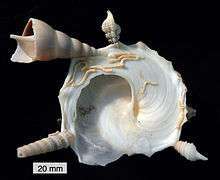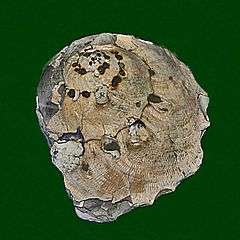Xenophora
| Xenophora Temporal range: Late Cretaceous–Recent | |
|---|---|
 | |
| A ventral view of a shell of Xenophora pallidula, with attached gastropod shells | |
 | |
| A lateral view of the same shell | |
| Scientific classification | |
| Kingdom: | Animalia |
| Phylum: | Mollusca |
| Class: | Gastropoda |
| (unranked): | clade Caenogastropoda clade Hypsogastropoda clade Littorinimorpha |
| Superfamily: | Xenophoroidea |
| Family: | Xenophoridae |
| Genus: | Xenophora Fischer von Waldheim, 1807[1] |
| Species | |
|
See text | |
| Synonyms | |
|
Xenophorus (incorrect subsequent spelling of Xenophora Fischer von Waldheim, 1807) | |
Xenophora, commonly called carrier shells, is a genus of medium-sized to large sea snails, marine gastropod mollusks in the family Xenophoridae, the carrier snails or carrier shells.[2] The genus Xenophora is the type genus of the family Xenophoridae.
Xenophora is also the name of the quarterly magazine of the French Conchologist Association.[3]
Etymology
The name Xenophora comes from two ancient Greek words, and means "bearing foreigners", so-called because in most species the snail cements pieces of rock or shells to its own shell at regular intervals as the shell grows.[4]
Description
The shells of species within this genus vary from small to large (diameter of base without attachments 19-90 mm; height of shell 21-60 mm), depressed-conical, with narrow to very narrow, simple peripheral edge, non-porcellanous ventrally. Foreign objects are attached to all whorls, with generally more than 30% of dorsal surface obscured by these objects. The foreign objects are usually medium-sized to large.[5] Although the foreign objects are usually mollusk shells, pebbles, or small pieces of coral rock, in some instances a bottle cap has been attached by the snail to its shell.
Species
The genus Xenophora includes the following species and subspecies:[5][6][7]
- Xenophora minuta Qi & Ma, 1986
- Xenophora robusta Verrill, 1870
- Subgenus Xenophora (Austrophora) Kreipl, Alf & Kronenberg, 1999
- Xenophora flindersi (Cotton & Godfrey, 1938)
- Subgenus Xenophora (Xenophora) Fischer von Waldheim, 1807
- Xenophora cerea (Reeve, 1845)
- Xenophora chinensis Philippi, 1841)
- Xenophora conchyliophora (Born, 1780) - American carriersnail (type species of Xenophora)
- Xenophora corrugata (Reeve, 1842)
- Xenophora crispa (König, 1825)
- Xenophora granulosa Ponder, 1983
- Xenophora indica Gmelin, 1791
- Xenophora japonica Kuroda & Habe in Kuroda et al., 1971
- Xenophora mekranensis konoi Habe, 1953
- Xenophora neozelanica Suter, 1908 - New Zealand carriershell
- Xenophora neozelandica neozelandica Suter, 1908
- Xenophora neozelandica kermadecensis Ponder, 1983
- Xenophora pallidula (Reeve, 1842) - pallid carrier shell
- Xenophora peroniana (Iredale, 1929)
- Xenophora peroniana peroniana (Iredale, 1929)
- Xenophora peroniana kondoi Ponder 1983
- Xenophora senegalensis Fischer, 1873
- Xenophora solarioides (Reeve, 1845)
- Xenophora tenuis Fulton, 1938
- Species brought into synonymy
- Subgenus Xenophora (Stellaria) Möller, 1832: synonym of Stellaria Möller, 1832
- Xenophora (Stellaria) testigera (Bronn, 1831): synonym of Stellaria testigera (Bronn, 1831)
- Xenophora australis Souverbie & Montrouzier, 1870: synonym of Xenophora (Xenophora) solarioides (Reeve, 1845)
- Xenophora calculifera (Reeve, 1843): synonym of Stellaria chinensis (Philippi, 1841)
- Xenophora caperata sensu Petit de la Saussaye, 1857: synonym of Xenophora (Xenophora) senegalensis Fischer, 1873
- Xenophora caribaea Petit de la Saussaye, 1857 - Caribbean carriersnail: synonym of Onustus caribaeus (Petit de la Saussaye, 1857)
- Xenophora cavelieri Rochebrune, 1883: synonym of Xenophora (Xenophora) senegalensis Fischer, 1873
- Xenophora digitata Martens, 1878: synonym of Stellaria testigera digitata Martens, 1878
- Xenophora gigantea (Schepman, 1909): synonym of Stellaria gigantea (Schepman, 1909)
- Xenophora helvacea Philippi, 1851: synonym of Onustus indicus (Gmelin, 1791)
- Xenophora japonica Kuroda & Habe, 1971: synonym of Xenophora (Xenophora) japonica Kuroda & Habe, 1971
- Xenophora konoi Habe, 1953: synonym of Xenophora (Xenophora) mekranensis konoi Habe, 1953
- Xenophora laevigata Fischer von Waldheim, 1807: synonym of Xenophora (Xenophora) conchyliophora (Born, 1780)
- Xenophora lamberti Souverbie, 1871: synonym of Stellaria lamberti (Souverbie, 1871)
- Xenophora longleyi Bartsch, 1931 - shingled carriersnail: synonym of Onustus longleyi Bartsch, 1931
- Xenophora meandrina Fischer von Waldheim, 1807: synonym of Xenophora (Xenophora) conchyliophora (Born, 1780)
- Xenophora mediterranea Tiberi, 1863: synonym of Xenophora (Xenophora) crispa (König, 1825)
- Xenophora neozelanica Suter, 1908: synonym of Xenophora (Xenophora) neozelanica neozelanica Suter, 1908
- Xenophora regularis Habe & Okutani, 1983 : synonym of Xenophora (Xenophora) granulosa Ponder, 1983
- Xenophora tenuis Hirase, 1934: synonym of Xenophora (Xenophora) tenuis Fulton, 1983
- Xenophora torrida Kuroda & Ito, 1961 : synonym of Xenophora (Xenophora) cerea (Reeve, 1845)
- Xenophora tricostata Fischer von Waldheim, 1807: synonym of Xenophora (Xenophora) conchyliophora (Born, 1780)
- Xenophora tulearensis Stewart & Kosuge, 1993: synonym of Xenophora (Xenophora) corrugata (Reeve, 1842)
- Xenophora vulcanica Fischer von Waldheim, 1807: synonym of Xenophora (Xenophora) conchyliophora (Born, 1780)
- Xenophora wagneri Philippi, 1855: synonym of Onustus indicus (Gmelin, 1791)
Extinct species

Extinct species within this genus include: [8]
- †Xenophora carditigera Nielsen and DeVries 2002
- †Xenophora cummulans Brongniart 1823
- †Xenophora delecta Guppy 1876
- †Xenophora deshayesi Michelotti 1847
- †Xenophora eocenica Abbass 1967
- †Xenophora floridana Mansfield 1930
- †Xenophora infundibulum (Brocchi, 1814)[9]
- †Xenophora palaeoafra Gliozzi and Malatesta 1983
- †Xenophora paulinae Nielsen and DeVries 2002
- †Xenophora rugata Abbass 1967
- †Xenophora tatei Harris 1897
- †Xenophora terpstrai Dey 1961
- †Xenophora textilina Dall 1892
Fossil record
Fossils of Xenophora are found in marine strata from the Cretaceous to Quaternary (age range: from 89.3 to 0.012 million years ago.). Fossils are known all over the world. [8][10]
See also
- Images of a live Xenophora conchyliophora, photographed in situ underwater by Anne DuPont
References
- ↑ Fischer von Waldheim J. (1807). Mus. Démid. 3: 213.
- ↑ WoRMS (2012). Xenophora. Accessed through: World Register of Marine Species at http://www.marinespecies.org/aphia.php?p=taxdetails&id=138664 on 2012-06-28
- ↑ Xenophora.org website accessed 24 April 2014
- ↑ Xenophora.org website accessed 24 April 2014
- 1 2 Kreipl, K. & Alf, A. (1999): Recent Xenophoridae. 148 pp. incl. 28 color plts. ConchBooks, Hackenheim, ISBN 3-925919-26-0.
- ↑ Powell A. W. B. (1979). New Zealand Mollusca, William Collins Publishers Ltd, Auckland, New Zealand. ISBN 0-00-216906-1
- ↑ OBIS Indo-Pacific Molluscan Database
- 1 2 Paleobiology Database
- ↑ Stromboidea
- ↑ G. Manganelli, V. Spadini, S. Cianfanelli The xenophorid gastropods of the Mediterranean Pliocene: the record of the Siena Basin
- Fischer von Waldheim G. 1806-1807. Muséum Demidoff, ou catalogue systématique et raisonné des curiosités de la nature et de l'art. Moscou Vol. 3 [1807] Végétaux et animaux page(s): vol. 3 p. 213
- Ponder W.F. (1983). A revision of the Recent Xenophoridae of the World and of the Australian Fossil Species (Mollusca : Gastropoda). Memoir 17. The Australian Museum Sydney, Australia
- Kreipl K. & Alf A. (1999). Recent Xenophoridae. Conchbooks, Hackenheim > Germany. 148pp.
| Wikimedia Commons has media related to Xenophora. |